About the new Canon Compact Servo 18-80 T4.4
Canon’s Compact Servo 18-80mm T4.4 EF-mount zoom for Super 35 cine format is a new kind of hybrid lens. It combines attributes of 3 lines of Canon lenses: L-Series EF professional still photography lenses, Cinema Zooms with manual focus/iris/zoom barrels, and Cine-Servo zooms.
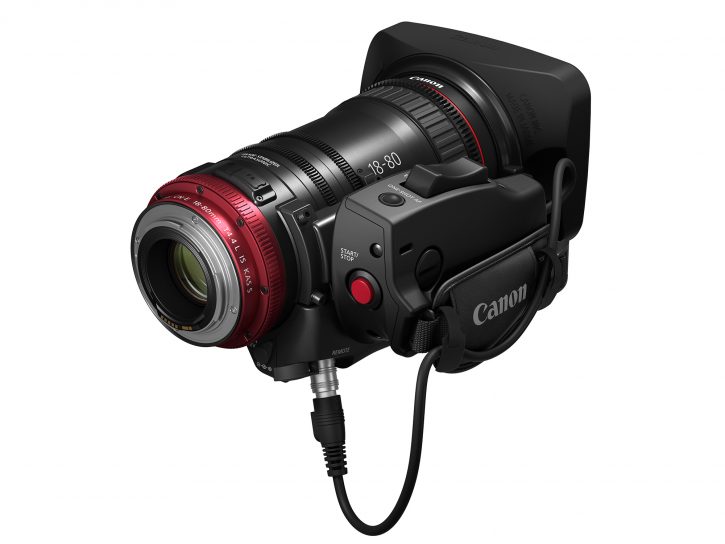
with handgrip attached
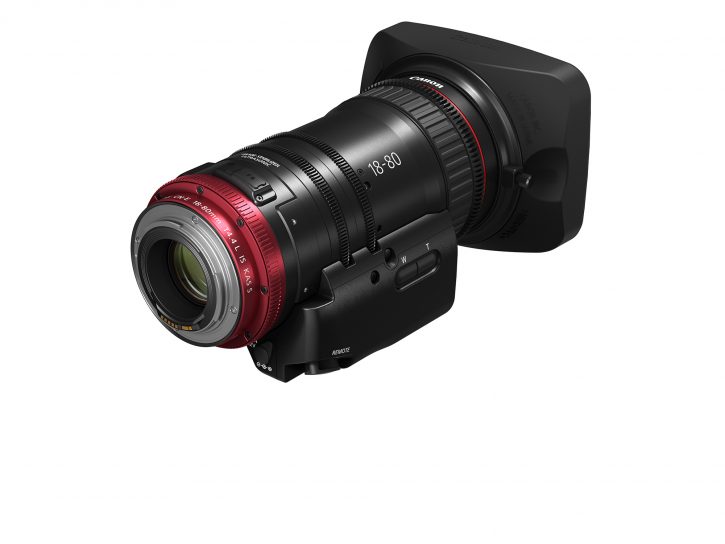
without handgrip
The 18-80 comes in an EF mount. It has optical image stabilization, something not often seen in cine lenses. Autofocus is compatible with EOS C300 Mark II and EOS C100 Mark II cameras. The optional servo handgrip is unique and very clever. It attaches with one screw. When removed, an electronic module containing the lens servo motors remains, along with its own redundant zoom rocker switch. The motors can be turned on or off. The advantage is that you don’t have to recalibrate or worry about gears not meshing.
Canon’s hybrid lens design combines image quality, ergonomics for video and cine, and an affordable price made possible by quantity production. The Canon Compact Servo 18-80mm Zoom Lens and ZSG-C10 accessory grip are scheduled to be available later in 2016 for a ridiculously low estimated retail price of $5,500 and $499 respectively. This is the first in a series of hybrid Compact-Servo cinematography lenses from Canon for handheld, shoulder, tripods or rigs.
A Conversation with Tetsushi Hibi and Yasunori Imaoka at Canon
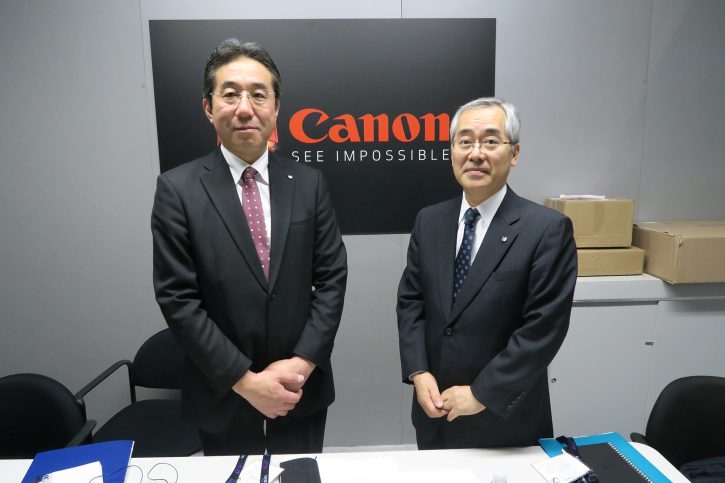
Tetsushi Hibi (left) and Yasunori Imaoka (right) at NAB 2016.
Recently, I met with Tetsushi Hibi, Senior General Manager, Canon Optics R&D Center; Yasunori Imaoka, Group Executive, Canon Image Communication Products; Ryan Kamata, Sr Specialist, Canon USA Camera & Video Division (who also translated); and Leigh Nofi , Canon Manager of Public Relations, Corporate Communications Division.
JON FAUER: How did you come up with the concept for the new Canon Compact Servo 18-80mm T4.4 EF Zoom Lens?
YASUNORI IMAOKA: We noticed that cameras were becoming more compact—but the lenses remained the same large size. We wanted to make a zoom lens for motion picture that matched the form factor of these new cameras so that the entire acquisition system would become more compact and flexible.
We also saw the increased use of gimbal and rig stabilizers. So desired to make this lens suitable for every possible application: handheld, shoulder mounted, on rigs, gimbals, drones, remote heads, for feature, television, documentary and ENG style cinematography. We think this lens can do all that. It is the result of listening to feedback from our customers and understanding the potential need for such a lens.
We noticed that many people who use our cine cameras, or other cameras with similar form factors or price points, also use Canon EF lenses. Many requests from those users were for us to provide a motion picture specific lens with the functionality of EF zoom lenses, auto-focus and image stabilization. They did not want to compromise on those functions. We incorporated those functions into the new product as well.
When did you first get the idea to create this lens?
IMAOKA: It was actually two years ago, at NAB. at’s when we started discussing the idea.
Did somebody say something? What was the creative spark?
IMAOKA: During NAB 2014, we had a room set up for internal staff meetings in the hotel. Mr. Hibi and I were sitting at a table with Canon representatives from around the world. At that point, it was brought up that we needed this type of lens. That was pretty much the first time we started thinking about it. Then we did a lot of research, met many cinematographers and end-users, and discussed what would be best. We studied hard. That took some time. Then we began designing and developing the product. And finally, two years from that day, we have come up with this exciting product and its hybrid concept.
Can you explain how it is a hybrid?
RYAN KAMATA: We basically have three different types of professional lenses: cinema, broadcast, and EF L Series still photography lenses. We wanted take the benefits from each of those professional lines and incorporate them into one lens. The result is the Compact Servo 18-80mm T4.4 EF zoom. For example, the benefits from the EF L still lenses are their auto functions and communication with the camera. From the cinema side, we have the manual control capabilities and gear pitch of the focus, iris and zoom barrels, as well as the form factor. From our broadcast lenses, we wanted to incorporate the servo capability. All these things have been incorporated into this one, single hybrid model. Of course, it’s just one lens in a series, which means that we will come out with something else in the near future. We will try to incorporate the same functions and features into whatever lenses are going to follow.
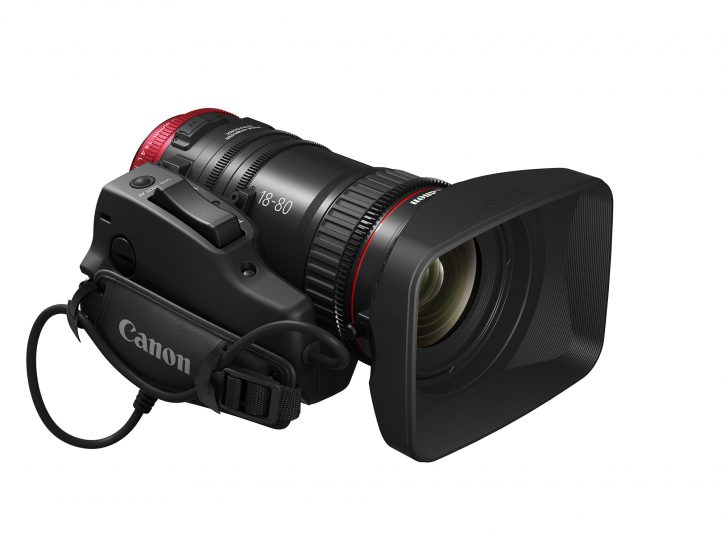 Why hasn’t this hybrid idea been done before?
Why hasn’t this hybrid idea been done before?
IMAOKA: Perhaps the reason is that Canon may be unique in terms of already having a large variety of lenses, including the three categories already mentioned: EF still photography, Cinema and Broadcast style lenses. We gathered opinions from all types of customers who have used those lenses.
The new 18-80 lens has many of the same features as your higher-end zoom lenses that cost a lot more. How were you able to make it so inexpensively?
IMAOKA: That was also our hope. We think that we can sell many of them, compared to regular cinema lenses which are delivered in smaller quantities. The larger quantity lowers the overall cost of manufacturing and hence the price.
Mass production?
IMAOKA: Yes. Canon has many different EF lens models. We have a long history of building and manufacturing lenses. We know how to design and build them in a more cost-effective way without compromising the performance. Therefore, it’s not just one thing, but a combination of many factors that made it possible for us to come out with such a cost-effective lens.
If a DP is buying your new hybrid 18-80 lens, are there any tradeoffs that the higher-end lenses might offer instead?
TETSUSHI HIBI: Two things: the zoom ratio, and the maximum T-stop.
Then it’s true that each increase by one T-stop almost doubles the price of the lens?
HIBI: Exactly.
What about optical quality? Is there a difference between this and your high-end cinema zooms?
HIBI: It’s the same high quality.
IMAOKA: We think that this lens has very, very high performance. At the same time, it is very cost effective.
Maybe you could charge more for it (laughs).
IMAOKA: I wish if we could do so. On the other hand, we want as many people as possible to experience this lens. The price obviously affects the number of people who can purchase it. We wanted everyone in the industry to have this lens because we believe in its capability.
Do you think it might hurt sales of the high-end cine zooms?
IMAOKA: I don’t think that this lens will affect the higher-end cinema lens business because it has different capabilities. This lens is more appropriate for handheld and mobile applications. Our previous cinema lenses have higher specifications and PL- mount compatibility. This is just a different lens. I don’t think that it would affect the PL lens business.
The 18-80 only comes in EF mount. Is it technically possible to replace the EF with a PL mount? Even if a third party did it?
IMAOKA: We think that it’s very difficult to convert it with a PL mount. It’s not impossible, but it would be a challenge. You’d lose lens data and some of the auto functions.
HIBI: Certainly, we will continue listening to what end-users tell us. We want people to experience the benefits of having the capability to communicate with the camera and utilize the auto functions. If there seems to be a need for other mounts, we can definitely consider it.
The EF mount offers lens data, aberration correction, electronic connections, power, stabilization, and auto-focus. You don’t have those in a PL mount.
HIBI: Correct.
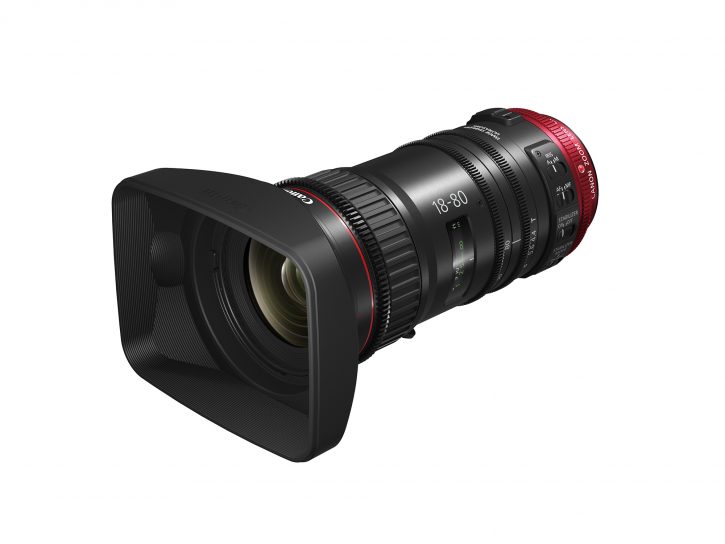
Is this zoom based on your EF 24-105mm f/4L IS USM lens?
IMAOKA: No, this is an entirely new lens design from the whiteboard. It is completely different. We designed it specifically for the Super 35 format. It is totally different from the 24-105, which is Full Format. We wanted to make the 18-80 as compact as possible and, at the same time, high performance. So we had to start from scratch.
Does it have the same optical performance as the 24-105?
IMAOKA : Yes, it’s actually as high as the 24-105, which is a very high-performance lens. Its resolution is 4K. As you know, the front of the 24-105 extends when it is zoomed to telephoto. The 18-80 barrel remains fixed when you’re zooming and focusing.
Would you please describe the design process? Were there various models and different focal lengths along the way?
HIBI: First, we established the concept of the lens. Then we did simulations to determine the best balance point, focal lengths, performance, weight, and size. That’s how we started the process.
IMAOKA: As for operability, we talked to end users as much as possible to get their feedback and to incorporate those ideas into the design concept. Then we worked on the details of the final version.
The removable servo handgrip is very unique. The main mechanism with handgrip comes off, leaving a module with the motors and a smaller zoom rocker on the lens. Can you describe how it works?
HIBI: From the beginning, versatility and mobility were the number one priority of the lens. We wanted to make it as flexible as possible. A permanently fixed servo unit is limiting, so the detachable handgrip unit was one thing that we had in mind from the beginning. Some people want to relocate the grip unit elsewhere. Our new setup allows the user to choose from a variety of configurations, keeping the motors in one module and the controls in the other. Compactness was the number one concern. However, having a motor on the lens barrel normally would depart from the concept of a compact form factor. So, we had to make the drive unit as small and lightweight as possible so that it would not interfere with the size or balance of the lens.
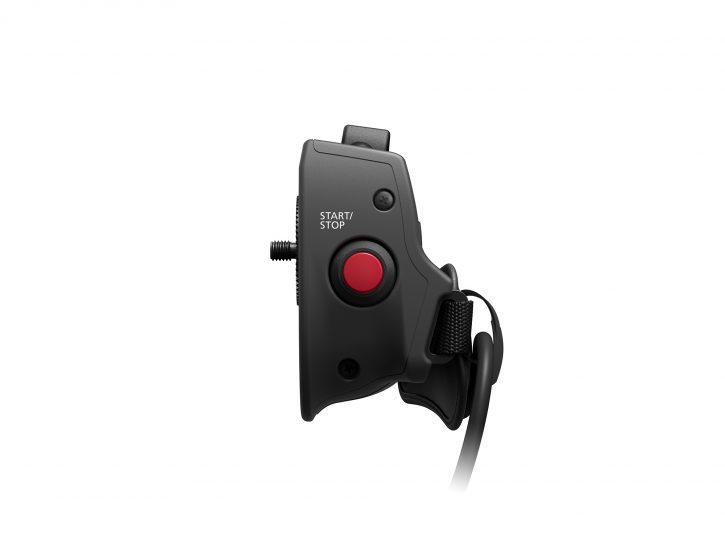
ZSG-C10 accessory handgrip
Did the requirement a small motor affect optical and mechanical design? The mechanical assemblies could not be too stiff and the optical elements would have to move quickly and accurately.
HIBI: That was exactly the case. We had to apply many thoughts into one design concept.
The 18-80 is a Super35 format lens. What about the future? Canon is famous for Full Frame cameras and lenses. Are you considering Full Frame cine zooms with a similar design concept?
IMAOKA: If we design the lens to cover a larger image format, that means that the lens will become larger proportionally. Full frame coverage (24×36 mm) is about 50 percent larger than Super 35 (18×24 mm), which will make the lens larger and heavier. We have to think carefully about this so we don’t depart too far from the compact design. Of course, if the demand for large format cine zooms increases, we will consider it. But it would require a different design. We call the 18-80 zoom a Compact Servo. If it’s not compact, we can’t call it Compact Servo anymore. That’s the big challenge.
Speaking of full frame, do you think the high-end cinema industry is going full frame or not? I was quite surprised that we didn’t see more new cameras at NAB.
IMAOKA: We hear comments that the movie industry might move forward with the larger sensor format. However, we’re not yet at the point where we can make those decisions. We are carefully observing how the market transitions. Introducing the compact servo 18-80 was a higher priority because we saw the immediate demand for such a lens in the Super 35mm format. Once the market moves ahead with a larger sensor camera, certainly we would proceed and begin designing products. But at this point, we’re not really sure. We’re not at the point where we can say yes or no to that question.
At NAB 2016, we saw footage from the RED W8K Large Format camera that was introduced last year. It is shipping now. (editorial note: At Cine Gear 2016, Panavision introduced their 8K Millennium DXL Camera, with the same sensor.) Both will shoot Large Format 8K as well as Super 35mm 4K on the same camera. Another large format camera is very popular: the Alexa 65. It offers many choices of formats and lenses.
KAMATA: How do you explain the interest in 65mm or Large Format?
I think it’s the look of large format, the shallower depth of eld, the wide choices of lenses, and resolution. It gives you the same shallow depth of field as anamorphic, but in a spherical format. I think the pendulum in cinema swings back and forth. Right now, maybe we’re in an anamorphic phase, but historically it always swings back to spherical large format.
KAMATA: It’s a creative process, with differentiations in approach and thoughts about the look.
Also at NAB, we saw a number of companies making full frame cine lenses by rebarreling existing still lenses. Full Frame lenses offer the flexibility to be used on a full frame sensor camera or a Super 35 camera.
KAMATA: Exactly, or even with a speed boost of a Full Frame lens adapted from Full Frame coverage to Super35.
Getting back to the 18-80, you said this is the first in a series. Would you care to comment on that?
IMAOKA: This is the first lens in the line, which means that we are considering the next ones in the near future. They haven’t been announced yet, so I can’t tell you the specifications, but we are trying to make them in different focal length ranges that make sense to complement the 18-80.
That’s good. Now we’ve come to the point in the discussion where you usually ask me what I would like to see next from Canon. I think when we met in April 2014, I dreamed of a small 150- 600. You smiled. And a few months later you introduced the 50-1000.
IMAOKA: What is your dream lens now?
Well, you’ve made many of them. But I can keep dreaming. Some colleagues have asked if you could make a shorter version of the 50-1000? Make it a 25-500 zoom? It would be good for sports.
IMAOKA: Halving the focal length is a challenge in terms of maintaining the high quality of the optics. It would have to be a different design lens. What format would you like?
At this point in history, we might as well go Full Frame. Otto Nemenz recently said that he’s so convinced that’s the future, he’s not going to buy many more Super 35mm lenses.
KAMATA: Yes. I keep hearing that from him too. Many times. Every time I go there.
Another dream lens would a cine version of your EF 11-24 full frame lens, no servo, for underwater housing and rigs. And T2.0. Could you do this?
KAMATA: We’re Canon. We try to make the impossible possible.
IMAOKA: We try to give our customers products that let them see the impossible.
HIBI: Our motto in Japan is “to make it possible with Canon.”








